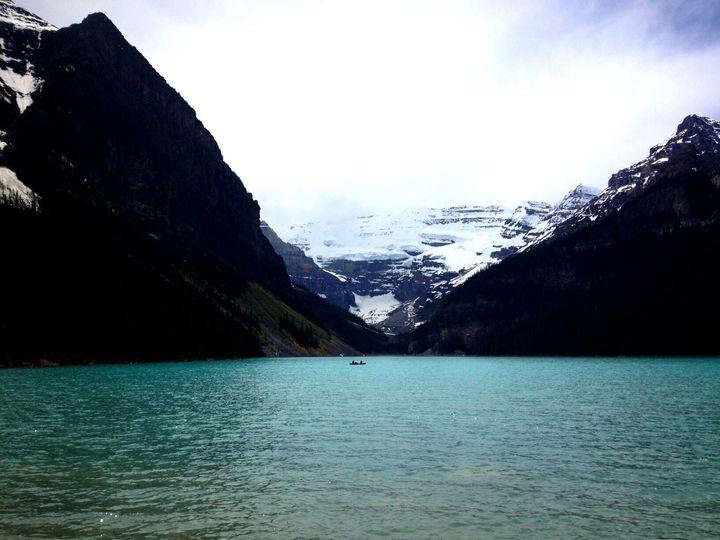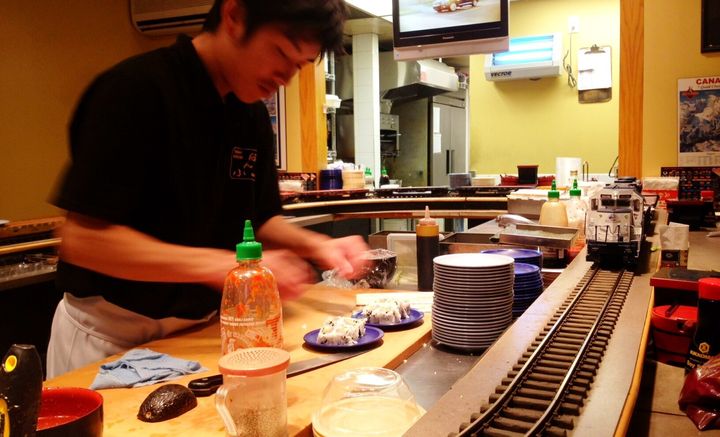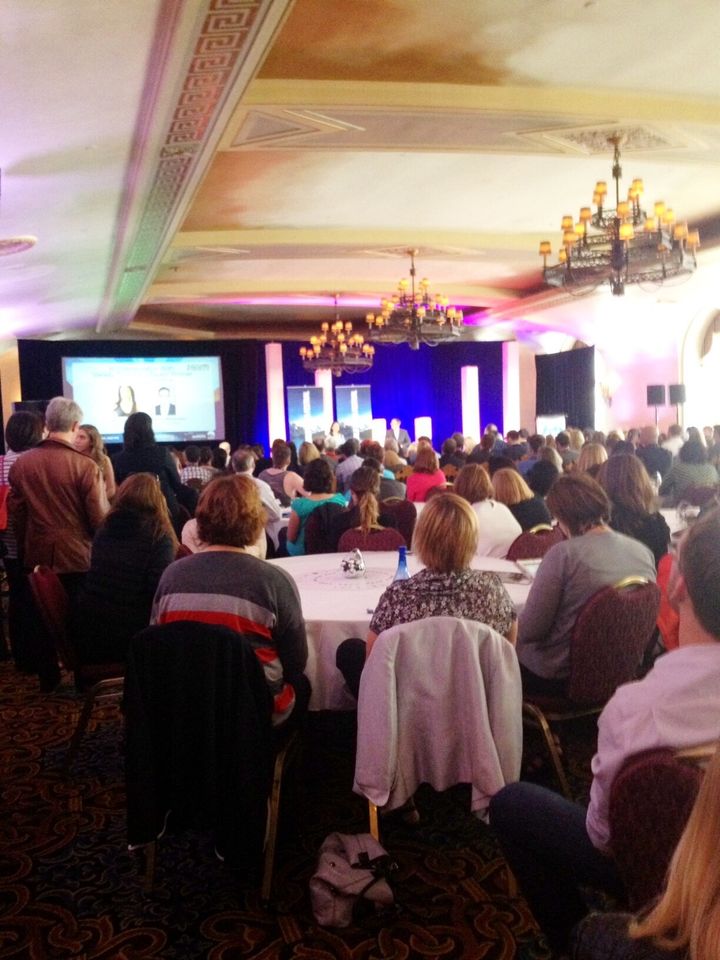Ayah Norris and Kyla Zanardi are Co-Creators of The INSIGHT Project, a digital media platform sharing stories, insights, and workshops from creative game-changers. As millennials and digital media producers, they offer their take on the future wave of media, gleaned from global digital leaders at the Banff World Media Festival.

It may have been the most whirlwind 48 hours we've ever had. Shortly after winning the Digital Media Storytelling pitch competition at the Innoversity Summit, our flights and hostel were booked. Just one week later, we were off to the Rockies for the 2013 Banff World Media Festival!
In between marvelling at the mountains and eating sushi from a toy Canadian Pacific train (trip highlight), we spent most of our time at the nextMEDIA leg of the conference. nextMEDIA is focused on the digital marketplace, and not surprisingly, Millennials were the hot topic. In all honesty, as PowerPoint after PowerPoint charted our video consumption rates and consumer behavior patterns, we often felt like subjects in the middle of an anthropological study. While some didn't quite understand Gen-Y and our cable-cord-cutting tendencies, there was a contingent of digital gurus that whole-heartedly embraced our mobile-first world. Here are some insights we picked up from the digital media leaders at #Banff2013:

BE REAL
Admittedly, we spend more time watching YouTube amateur vids of babies laughing and 100,000-calorie epic meals than we do sitting at home in front of our TV-sets watching primetime shows. And if we are watching TV on our parents' flat-screen, chances are we're scrolling through our Twitter feed, Instagram and texting about just how much Lena Dunham epitomizes our own real-life problems. Nobody understood this better than David Shing, Digital Prophet at AOL, millennial expert, and conference rock star. In a one hour presentation condensed into 10 minutes (how appropriate for Gen-Y), Shing accurately explains how Gen-Y is at the forefront of the rapidly evolving media landscape. He describes a world where kids are born connected; where 57% of us would rather speak to people digitally than analog; where your phone is the first screen not second; where contagious disposable content (with the likes of Snapchat & Vine) are flooding our streams; and finally, a world where it's more important to curate conversations than content. He reminded us that to tap into the hearts and pockets of millennials, the focus must to shift to authenticity, simplicity, and getting the conversation going.

PEACE OUT WATER COOLER, HELLO MOBILE
Conversations are changing. No one articulated this better than Mike Kasprow, Co-Founder and VP of Creative at Trapeze (and our adopted Banff Godfather). Kasprow grabbed our attention during a nextMEDIA panel asking some tough questions from North America's top media and creative agencies. Kasprow quickly pointed out the growing challenge with traditional media programming and ad buys, explaining that Gen-Y were tuning into very different channels (couldn't help ourselves) for their content consumption. When one panelist described the quintessential water cooler post-show recap at the office, Kasprow quickly fought back, explaining Gen-Y'ers talking about primetime television was outdated and irrelevant to the video-on-demand, content-binging Gen-Y cohort. We're watching content when it's most convenient to our schedules, and more importantly, the conversation is happening in real-time on our tablets and smartphones.
FEED THE BEAST
Confession: we're bingers. You know what were talking about: wait for a full season of Game of Thrones to come out, block off a 'sick day,' and marathon all 10 episodes online. We've all been there. The way we watch and consume content is quickly evolving -- we're demanding more content, and we want it accessible and on-demand. Transmedia projects like the Lizzie Bennet Diaries, an online modern-day adaptation of Pride and Prejudice, know exactly how to do this. In a panel bringing together big-budget Transmedia project leaders,Lizzie Bennet Diaries Co-Founder Bernie Su walked us through the multiple and plentiful story touchpoints, from video diaries on YouTube, to posts on Tumblr, to rants from characters on Twitter. Even better news for creators? When Lizzie Bennet Diaries launched a Kickstarter campaign with a $60,000 target to create a DVD box set, a staggering 7,000+ fans came to their aid to raise over $460,000. If we're hooked, we'll pay.
BRAND UP
One thing was clear: the traditional broadcaster/creator relationship is increasingly shifting to a brand/creator relationship. There's no better example of this than VICE's The Creators Project, one of the many wildly successful initiatives that led VICE to win the Award of Innovation at Banff 2013. A partnership with Intel, The Creators Project features exclusive interviews, events, and video portraits surrounding the impact of technology in music, art, film, and design. It's a win-win-win: VICE gets a multi-million dollar contract to produce content, Intel taps into VICE's community of influential millennials across the globe, and we the people get some pretty cool stuff. In an intimate talk reflecting on VICE's 18-year climb to power, co-founder and CEO Shane Smith said Intel had no problems proving ROI to the big women and men at the top: The Creators Project boosted brand recognition over 30 per cent, and gave them cross-channel activation opportunities, all in an authentic way. Not surprisingly, Intel continues to up their investment in the Creators Project, co-creating more and more content each year.
TELL US STORIES
According to forecasts by eMarketer, "by 2016, marketers in Canada will spend $360.5-million on digital video advertising, nearly 10 times the amount they spent in 2010." If you're a brand reading this: use those budgets to tell us stories. Your 30-second ad won't convert us, even if it ever reaches us. As agency Evidently (creators of Dear 16 Year Old Me) reminded us during a digital storytelling workshop,
Tell me a fact and I'll learn. Tell me a truth and I'll believe. But tell me a story and it'll live in my heart forever. (Native American proverb)
Somewhere along the line brands became obsessed with shouting their brand pillars at us. We successfully learned how to tune them out in the clutter. Thankfully, agencies like Evidently and brand/creator partnerships like The Creator's Project are leading the way back to story.
ALL HAIL YOUTUBE
nextMEDIA closed off strong with a keynote from George Strompolos (that's Strompo, not Strombo), founder of Fullscreen. Set to be the next Viacom, Fullscreen is a multi-channel network with over 15,000 YouTube channels under its umbrella, including top hits like World's Most Insane Rope Swing Ever and How Animals Eat Their Food (seriously, watch them). They count a record 2-billion monthly views from 175 million subscribers. Not too shabby. After giving us the lowdown on Fullscreen and it's successes, George charted some great tips for creators: Study what works before you get started (check out YouTube Charts), think high-concept low-cost, and ask yourself, "Would someone share this? Would they feel cool if they did?" Perhaps most bold at a place where many a traditional producer/broadcaster pitch meeting still takes place, George had novel advice: Don't pitch your idea. Create it.
YOU CAN RUN, BUT YOU CAN'T HIDE
The average viewer age of CNN is in their mid-sixties. The average VICE viewer is in their mid-twenties. To the old guard: You can try and fight it, but we'll place our bets that even when we can afford to move out of our parents' basement and step-up our meals from ramen (just kidding, we'll always love ramen), its safe to say that a $100+ cable subscription won't be at the top of our must-have list.
Follow The INSIGHT Project at @insight_project.